Chapter: 11th Physics : UNIT 3 : Laws of Motion
Solved Example Problems on Application of Newton’s Laws
APPLICATION OF NEWTON’S LAWS
Free Body Diagram
Free body diagram is a simple tool to analyse the motion of the object using Newton’s laws.
The following systematic steps are followed for developing the free body diagram:
· Identify the forces acting on the object.
· Represent the object as a point.
· Draw the vectors representing the forces acting on the object.
When we draw the free body diagram for an object or a system, the forces exerted by the object should not be included in the free body diagram.
Example 3.1
A book of mass m is at rest on the table.
1) What are the forces acting on the book?
2) What are the forces exerted by the book? (3) Draw the free body diagram for the book.
Solution
1) There are two forces acting on the book.
i. Gravitational force (mg) acting downwards on the book
ii. Normal contact force (N) exerted by the surface of the table on the book. It acts upwards as shown in the figure.
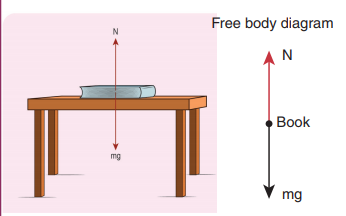
2) According to Newton’s third law, there are two reaction forces exerted by the book.
i. The book exerts an equal and opposite force (mg) on the Earth which acts upwards.
ii. The book exerts a force which is equal and opposite to normal force on the surface of the table (N) acting downwards.
3) The free body diagram of the book is shown in the figure.
Example 3.2
If two objects of masses 2.5 kg and 100 kg experience the same force 5 N, what is the acceleration experienced by each of them?
Solution
From Newton’s second law (in magnitude form), F = ma
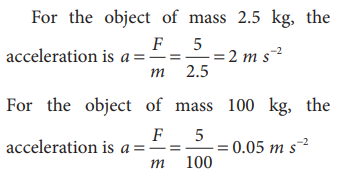
When an apple falls, it experiences Earth’s gravitational force. According to Newton’s third law, the apple exerts equal and opposite force on the Earth. Even though both the apple and Earth experience the same force, their acceleration is different. The mass of Earth is enormous compared to that of an apple. So an apple experiences larger acceleration and the Earth experiences almost negligible acceleration. Due to the negligible acceleration, Earth appears to be stationary when an apple falls.
Example 3.3
Which is the greatest force among the three force  shown below
shown below

Solution
Force is a vector and magnitude of the vector is represented by the length of the vector. Here ![]() has greater length compared to other two. So
has greater length compared to other two. So ![]() is largest of the three.
is largest of the three.
Example 3.4
Apply Newton’s second law to a mango hanging from a tree. (Mass of the mango is 400 gm)
Solution
Note: Before applying Newton’s laws, the following steps have to be followed:
1. Choose a suitable inertial coordinate system to analyse the problem. For most of the cases we can take Earth as an inertial coordinate system.
2. Identify the system to which Newton’s laws need to be applied. The system can be a single object or more than one object.
3. Draw the free body diagram.
4. Once the forces acting on the system are identified, and the free body diagram is drawn, apply Newton’s second law. In the left hand side of the equation, write the forces acting on the system in vector notation and equate it to the right hand side of equation which is the product of mass and acceleration. Here, acceleration should also be in vector notation.
5. If acceleration is given, the force can be calculated. If the force is given, acceleration can be calculated.
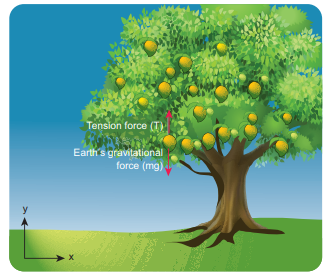
By following the above steps:
We fix the inertial coordinate system on the ground as shown in the figure.
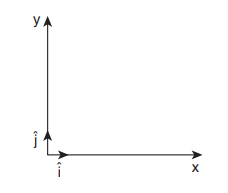
The forces acting on the mango are
i. Gravitational force exerted by the Earth on the mango acting downward along negative y axis
ii. Tension (in the cord attached to the mango) acts upward along positive y axis.
The free body diagram for the mango is shown in the figure
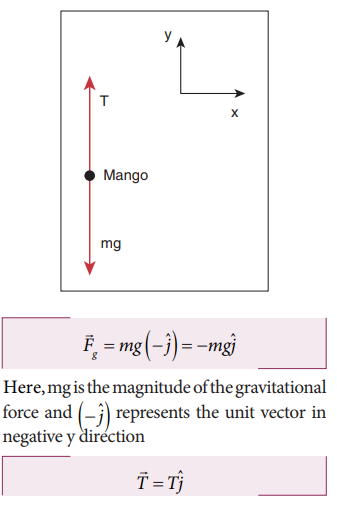

Example 3.5
A person rides a bike with a constant velocity ![]() with respect to ground and another biker accelerates with acceleration
with respect to ground and another biker accelerates with acceleration ![]() with respect to ground. Who can apply Newton’s second law with respect to a stationary observer on the ground?
with respect to ground. Who can apply Newton’s second law with respect to a stationary observer on the ground?
Solution
Second biker cannot apply Newton’s second law, because he is moving with acceleration ![]() with respect to Earth (he is not in inertial frame). But the first biker can apply Newton’s second law because he is moving at constant velocity with respect to Earth (he is in inertial frame).
with respect to Earth (he is not in inertial frame). But the first biker can apply Newton’s second law because he is moving at constant velocity with respect to Earth (he is in inertial frame).
Example 3.6
The position vector of a particle is given  which the particle experiences net force?
which the particle experiences net force?
Solution
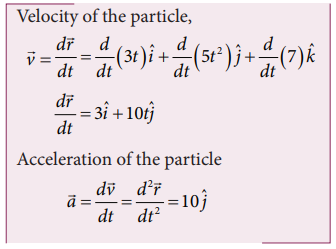
Here, the particle has acceleration only along positive y direction. According to Newton’s second law, net force must also act along positive y direction. In addition, the particle has constant velocity in positive x direction and no velocity in z direction. Hence, there are no net force along x or z direction.
Example 3.7
Consider a bob attached to a string, hanging from a stand. It oscillates as shown in the figure.
Solution
a) Identify the forces that act on the bob?
b) b) What is the acceleration experienced by the bob?
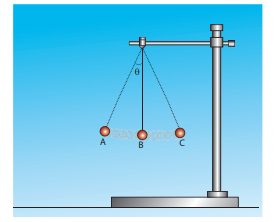
Two forces act on the bob.
(i) Gravitational force (mg) acting downwards
(ii) Tension (T) exerted by the string on the bob, whose position determines the direction of T as shown in figure.
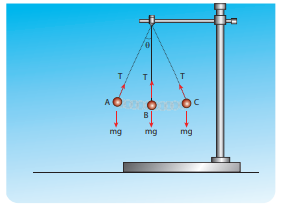
The bob is moving in a circular arc as shown in the above figure. Hence it has centripetal acceleration. At a point A and C, the bob comes to rest momentarily and then its velocity increases when it moves towards point B. Hence, there is a tangential acceleration along the arc. The gravitational force can be resolved into two components (mg cosθ, mg sinθ) as shown below
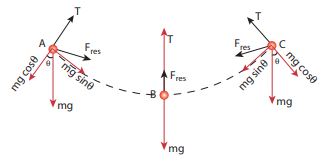
Example 3.8
The velocity of a particle moving in a plane is given by the following diagram. Find out the direction of force acting on the particle?
Solution
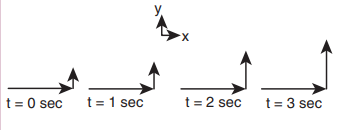
The velocity of the particle is  As shown in the figure, the particle is moving in the xy plane, there is no motion in the z direction. So velocity in the z direction is zero (vz = 0). The velocity of the particle has x component (vx) and y component (v y). From figure, as time increases from t = 0 sec to t = 3 sec, the length of the vector in y direction is changing (increasing). It means component of velocity ( vy ) is increasing with respect to time. According to Newton’s second law, if velocity changes with respect to time then there must be acceleration. In this case, the particle has acceleration in the y direction since the y component of velocity changes. So the particle experiences force in the y direction. The length of the vector in x direction does not change. It means that the particle has constant velocity in the x direction. So no force or zero net force acts in the x direction.
As shown in the figure, the particle is moving in the xy plane, there is no motion in the z direction. So velocity in the z direction is zero (vz = 0). The velocity of the particle has x component (vx) and y component (v y). From figure, as time increases from t = 0 sec to t = 3 sec, the length of the vector in y direction is changing (increasing). It means component of velocity ( vy ) is increasing with respect to time. According to Newton’s second law, if velocity changes with respect to time then there must be acceleration. In this case, the particle has acceleration in the y direction since the y component of velocity changes. So the particle experiences force in the y direction. The length of the vector in x direction does not change. It means that the particle has constant velocity in the x direction. So no force or zero net force acts in the x direction.
Example 3.9
Apply Newton’s second law for an object at rest on Earth and analyse the result.
Solution
The object is at rest with respect to Earth (inertial coordinate system). There are two forces that act on the object.
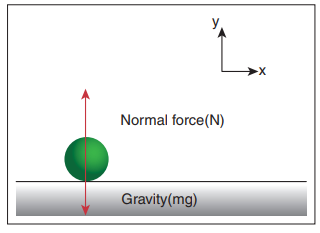
i. Gravity acting downward (negative y-direction)
ii. Normal force by the surface of the Earth acting upward (positive y-direction)
The free body diagram for this object is

By comparing the components on both sides of the equation, we get

We can conclude that if the object is at rest, the magnitude of normal force is exactly equal to the magnitude of gravity.
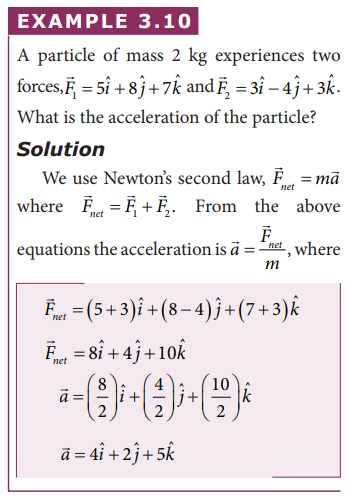
Identify the forces acting on blocks A, B and C shown in the figure.
Solution
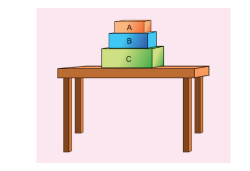
Forces on block A:
i. Downward gravitational force exerted by the Earth (mAg)
ii. Upward normal force (NB) exerted by block B (NB)
The free body diagram for block A is as shown in the following picture.
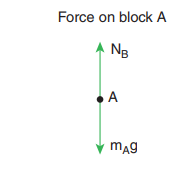
Forces on block B :
i. Downward gravitational force exerted by Earth (mBg)
ii. Downward force exerted by block A (NA)
iii. Upward normal force exerted by block C (NC)
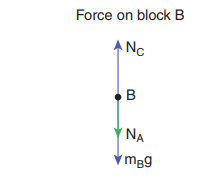
Forces onblock C:
i. Downward gravitational force exerted by Earth (mCg)
ii. Downward force exerted by block B (NB)
iii. Upward force exerted by the table (Ntable)
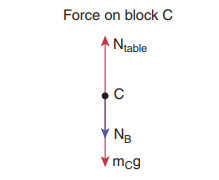
Example 3.12
Consider a horse attached to the cart which is initially at rest. If the horse starts walking forward, the cart also accelerates in the forward direction. If the horse pulls the cart with force Fh in forward direction, then according to Newton’s third law, the cart also pulls the horse by equivalent opposite force Fc = Fh in backward direction. Then total force on ‘cart+horse’ is zero. Why is it then the ‘cart+horse’ accelerates and moves forward?
Solution
This paradox arises due to wrong application of Newton’s second and third laws. Before applying Newton’s laws, we should decide ‘what is the system?’. Once we identify the ‘system’, then it is possible to identify all the forces acting on the system. We should not consider the force exerted by the system. If there is an unbalanced force acting on the system, then it should have acceleration in the direction of the resultant force. By following these steps we will analyse the horse and cart motion.
If we decide on the cart+horse as a ‘system’, then we should not consider the force exerted by the horse on the cart or the force exerted by cart on the horse. Both are internal forces acting on each other. According to Newton’s third law, total internal force acting on the system is zero and it cannot accelerate the system. The acceleration of the system is caused by some external force. In this case, the force exerted by the road on the system is the external force acting on the system. It is wrong to conclude that the total force acting on the system (cart+horse) is zero without including all the forces acting on the system. The road is pushing the horse and cart forward with acceleration. As there is an external force acting on the system, Newton’s second law has to be applied and not Newton’s third law.
The following figures illustrates this.
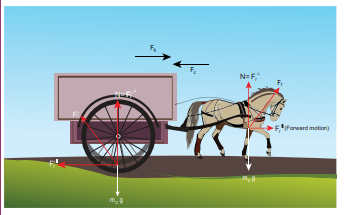
If we consider the horse as the ‘system’, then there are three forces acting on the horse.
i. Downward gravitational force (mh g )
ii. Force exerted by the road (Fr )
iii. Backward force exerted by the cart (Fc )
It is shown in the following figure.
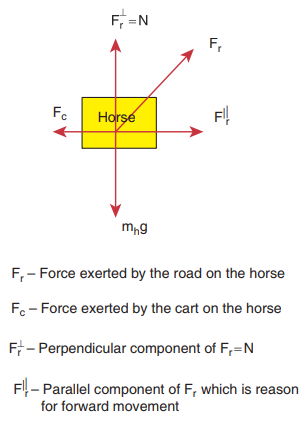
The force exerted by the road can be resolved into parallel and perpendicular components. The perpendicular component balances the downward gravitational force. There is parallel component along the forward direction. It is greater than the backward force (Fc ). So there is net force along the forward direction which causes the forward movement of the horse.
If we take the cart as the system, then there are three forces acting on the cart.
i. Downward gravitational force (mc g)
ii. Force exerted by the road ( Fr’ )
iii. Force exerted by the horse (Fh )
It is shown in the figure
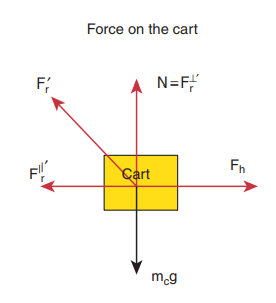
The force exerted by the road ( ![]() ) can be resolved into parallel and perpendicular components. The perpendicular component cancels the downward gravity (mc g). Parallel component acts backwards and the force exerted by the horse (
) can be resolved into parallel and perpendicular components. The perpendicular component cancels the downward gravity (mc g). Parallel component acts backwards and the force exerted by the horse (![]() ) acts forward. Force (
) acts forward. Force (![]() ) is greater than the parallel component acting in the opposite direction. So there is an overall unbalanced force in the forward direction which causes the cart to accelerate forward.
) is greater than the parallel component acting in the opposite direction. So there is an overall unbalanced force in the forward direction which causes the cart to accelerate forward.
If we take the cart+horse as a system, then there are two forces acting on the system.
i. Downward gravitational force (mh + mc)g
ii. The force exerted by the road (Fr ) on the system.
It is shown in the following figure.
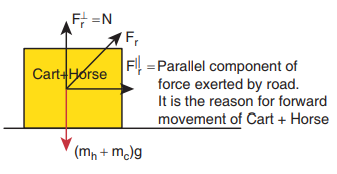
(iii) In this case the force exerted by the road (Fr ) on the system (cart+horse) is resolved in to parallel and perpendicular components. The perpendicular component is the normal force which cancels the downward gravitational force (mh + mc)g. The parallel component of the force is not balanced, hence the system (cart+horse) accelerates and moves forward due to this force.
Example 3.13
The position of the particle is represented by y = ut – 1/2 gt2 .
a) What is the force acting on the particle?
b) What is the momentum of the particle?
Solution
To find the force, we need to find the acceleration experienced by the particle.
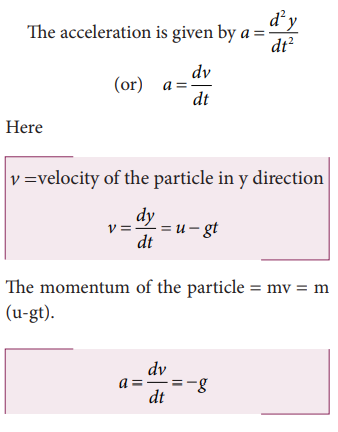
The momentum of the particle = mv = m (u-gt).
The force acting on the object is given by F = ma = −mg
The negative sign implies that the force is acting on the negative y direction. This is exactly the force that acts on the object in projectile motion.
Related Topics